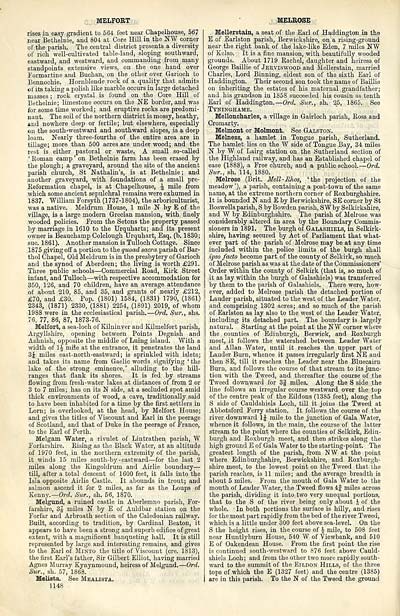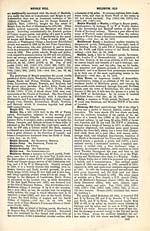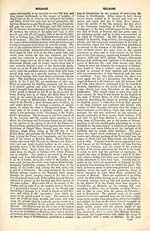Ordnance gazetteer of Scotland
(1156) Page 1148
Download files
Complete book:
Individual page:
Thumbnail gallery: Grid view | List view

MELFORT
rises in easy gradient to 564 feet near ChapeLhouse, 567
near Bethelnie, and 804 at Core Hill in the NW corner
of the parish. The central district presents a diversity
of rich well-cultivated table-land, sloping southward,
eastward, and westward, and commanding from many
standpoints extensive views, on the one hand over
Formartine and Buchan, on the other over Garioch to
Bennochie. Hornblende rock of a quality that admits
of its taking a polish like marble occurs in large detached
masses ; rock crystal is found on the Core Hill of
Bethelnie; limestone occurs on the NE border, and was
for some time worked; and eruptive rocks are predomi-
nant. The soil of the northern district is mossy, heathy,
and nowhere deep or fertile; but elsewhere, especially
on the south-westward and southward slopes, is a deep
loam. Nearly three-fourths of the entire area are in
tillage; more than 500 acres are underwood; and the
rest is either pastoral or waste. A small so-called
' Roman camp ' on Bethelnie farm has been erased by
the plough ; a graveyard, around the site of the ancient
parish church, St Nathalin's, is at Bethelnie; and
another graveyard, with foundations of a small pre-
Reformation chapel, is at Chapelhouse, \ mile from
which some ancient sepulchral remains were exhumed in
1837. William Forsyth (1737-1804), the arboriculturist,
was a native. Meldrum House, 1 mile N by E of the
village, is a large modern Grecian mansion, with finely
wooded policies. From the Setons the property passed
by marriage in 1610 to the Urquharts; and its present
owner is Beauchamp Colclough Urquhart, Esq. (b. 1830;
sue. 1861). Another mansion is Tulloch Cottage. Since
1875 giving off a portion to the quoad sacra parish of Bar-
thol Chapel, Old Meldrum is in the presbytery of Garioch
and the synod of Aberdeen; the living is worth £291.
Three public schools — Commercial Road, Kirk Street
infant, and Tulloch — with respective accommodation for
350, 126, and 70 children, have an average attendance
of about 210, 85, and 35, and grants of nearly £212,
£70, and £30. Pop. (1801) 1584, (1831) 1790, (1861)
2343, (1871) 2330, (1881) 2254, (1891) 2019, of whom
1988 were in the ecclesiastical parish. — Ord. Sur., shs.
76, 77, 86, 87, 1873-76.
Melfort, a sea-loch of Kilninver and Kilmelfort parish,
Argyllshire, opening between Points Degnish and
Ashnish, opposite the middle of Luing island. With a
width of 1$ mfte at the entrance, it penetrates the land
3 J miles east-north-eastward; is sprinkled with islets;
and takes its name from Gaelic words signifying ' the
lake of the strong eminence,' alluding to the hill-
ranges that flank its shores. It is fed by streams
flowing from fresh-water lakes at distances of from 2 or
3 to 7 miles ; has on its N side, at a secluded spot amid
thick environments of wood, a cave, traditionally said
to have been inhabited for a time by the first settlers in
Lorn; is overlooked, at the head, by Melfort House;
and gives the titles of Viscount and Earl in the peerage
of Scotland, and that of Duke in the peerage of France,
to the Earl of Perth.
Melgam Water, a rivulet of Lintratheu parish, W
Forfarshire. Rising as the Black Water, at an altitude
of 1970 feet, in the northern extremity of the parish,
it winds 15 miles south-by -eastward — for the last 2
miles along the Kingoldrum and Airlie boundary —
till, after a total descent of 1600 feet, it falls into the
Isla opposite Airlie Castle. It abounds in trout; and
salmon ascend it for 2 miles, as far as the Loups of
Kenny.— Ord. Sur., sh. 56, 1870.
Melgund, a ruined castle in Aberlemno parish, For-
farshire, 3| miles H by E of Auldbar station on the
Forfar and Arbroath section of the Caledonian railway.
Built, according to tradition, by Cardinal Beaton, it
appears to have been a strong and superb edifice of great
extent, with a magnificent banqueting hall. It is still
represented by large and interesting remains, and gives
to the Earl of Minto the title of Viscount (ere. 1813),
the first Earl's father, Sir Gilbert Elliot, having married
Agnes Murray Kynynmound, heiress of Melgund. — Ord.
Sur., ah. 57, 1868.
Melista. See Mealista.
1148
MELROSE
Mellerstain, a seat of the Earl of Haddington in the
E of Earlston parish, Berwickshire, on a rising-ground
near the right bank of the lake-like Eden, 7 miles NW
of Kelso. It is a fine mansion, with beautifully wooded
grounds. About 1719 Rachel, daughter and heiress of
George Baillie of Jebviswood and Mellerstain, married
Charles, Lord Binning, eldest son of the sixth Earl of
Haddington. Their second son took the name of Baillie
on inheriting the estates of his maternal grandfather;
and his grandson in 1858 succeeded his cousin as tenth
Earl of Haddington.— Ord. Sur., sh. 25, 1865. See
Tyninghame.
Melloacharles, a village in Gairloch parish, Ross and
Cromarty.
Melmont or Molmont. See Galston.
Melness, a hamlet in Tongue parish, Sutherland.
The hamlet lies on the W side of Tongue Bay, 34 miles
N by W of Lairg station on the Sutherland section of
the Highland railway, and has an Established chapel of
ease (1888), a Free church, and a public school.— Ord.
Sur., sh. 114, 1880.
Melrose (Brit. Mell-Khos, 'the projection of the
meadow '), a parish, containing a post-town of the same
name, at the extreme northern corner of Roxburghshire.
It is bounded N and E by Berwickshire, SE corner by St
Boswells parish, S by Bowden parish, S W by Selkirkshire,
and W by Edinburghshire. The parish of Melrose was
considerably altered in area by the Boundary Commis-
sioners in 1891. The burgh of Galashiels, in Selkirk-
shire, having secured by Act of Parliament that what-
ever part of the parish of Melrose may be at any time
included within the police limits of the burgh shall
ipso facto become part of the county of Selkirk, so much
of Melrose parish as was at the date of the Commissioners'
Order within the county of Selkirk (that is, so much of
it as lay within the burgh of Galashiels) was transferred
by them to the parish of Galashiels. There were, how-
ever, added to Melrose parish the detached portion of
Lauder parish, situated to the west of the Leader Water,
and comprising 1302 acres; and so much of the parish
of Earlston as lay also to the west of the Leader Water,
including its detached part. The boundary is largely
natural. Starting at the point at the NW corner where
the counties of Edinburgh, Berwick, and Roxburgh
meet, it follows the watershed between Leader Water
and Allan Water, until it reaches the upper part of
Lauder Burn, whence it passes irregularly first NE and
then SE, till it reaches the Leader near the Bluecairn
Burn, and follows the course of that stream to its junc-
tion with the Tweed, and thereafter the course of the
Tweed downward for 3| miles. Along the S side the
line follows an irregular course westward over the top
of the centre peak of the Eildons (1385 feet), along the
S side of Cauldshiels Loch, till it joins the Tweed at
Abbotsford Ferry station. It follows the course of the
river downward 1J mile to the junction of Gala Water,
whence it follows, in the main, the course of the latter
stream to the point where the counties of Selkirk, Edin-
burgh and Roxburgh meet, and then strikes along the
high ground E of Gala Water to the starting-point. The
greatest length of the parish, from NW at the point
where Edinburghshire, Berwickshire, and Roxburgh-
shire meet, to the lowest point on the Tweed that the
parish reaches, is 11 miles; and the average breadth is
about 5 miles. From the mouth of Gala Water to the
mouth of Leader Water, the Tweed flows 4| miles across
the parish, dividing it into two very unequal portions,
that to the S of the river being only about I of the
whole. ■ In both portions the surface is hilly, and rises
for the most part rapidly from the bed of the river Tweed,
which is a little under 300 feet above sea-level. On the
S the height rises, in the course of £ mile, to 508 feet
near Huntlyburn House, 540 W of Viewbank, and 510
E of Oakendean House. From the first point the rise
is continued south-westward to 876 feet above Cauld-
shiels Loch; and from the other two more rapidly south-
ward to the summit of the Eildon Hills, of the three
tops cf which the E (1327 feet) and the centre (1385)
are in this parish. To the N of the Tweed the ground
rises in easy gradient to 564 feet near ChapeLhouse, 567
near Bethelnie, and 804 at Core Hill in the NW corner
of the parish. The central district presents a diversity
of rich well-cultivated table-land, sloping southward,
eastward, and westward, and commanding from many
standpoints extensive views, on the one hand over
Formartine and Buchan, on the other over Garioch to
Bennochie. Hornblende rock of a quality that admits
of its taking a polish like marble occurs in large detached
masses ; rock crystal is found on the Core Hill of
Bethelnie; limestone occurs on the NE border, and was
for some time worked; and eruptive rocks are predomi-
nant. The soil of the northern district is mossy, heathy,
and nowhere deep or fertile; but elsewhere, especially
on the south-westward and southward slopes, is a deep
loam. Nearly three-fourths of the entire area are in
tillage; more than 500 acres are underwood; and the
rest is either pastoral or waste. A small so-called
' Roman camp ' on Bethelnie farm has been erased by
the plough ; a graveyard, around the site of the ancient
parish church, St Nathalin's, is at Bethelnie; and
another graveyard, with foundations of a small pre-
Reformation chapel, is at Chapelhouse, \ mile from
which some ancient sepulchral remains were exhumed in
1837. William Forsyth (1737-1804), the arboriculturist,
was a native. Meldrum House, 1 mile N by E of the
village, is a large modern Grecian mansion, with finely
wooded policies. From the Setons the property passed
by marriage in 1610 to the Urquharts; and its present
owner is Beauchamp Colclough Urquhart, Esq. (b. 1830;
sue. 1861). Another mansion is Tulloch Cottage. Since
1875 giving off a portion to the quoad sacra parish of Bar-
thol Chapel, Old Meldrum is in the presbytery of Garioch
and the synod of Aberdeen; the living is worth £291.
Three public schools — Commercial Road, Kirk Street
infant, and Tulloch — with respective accommodation for
350, 126, and 70 children, have an average attendance
of about 210, 85, and 35, and grants of nearly £212,
£70, and £30. Pop. (1801) 1584, (1831) 1790, (1861)
2343, (1871) 2330, (1881) 2254, (1891) 2019, of whom
1988 were in the ecclesiastical parish. — Ord. Sur., shs.
76, 77, 86, 87, 1873-76.
Melfort, a sea-loch of Kilninver and Kilmelfort parish,
Argyllshire, opening between Points Degnish and
Ashnish, opposite the middle of Luing island. With a
width of 1$ mfte at the entrance, it penetrates the land
3 J miles east-north-eastward; is sprinkled with islets;
and takes its name from Gaelic words signifying ' the
lake of the strong eminence,' alluding to the hill-
ranges that flank its shores. It is fed by streams
flowing from fresh-water lakes at distances of from 2 or
3 to 7 miles ; has on its N side, at a secluded spot amid
thick environments of wood, a cave, traditionally said
to have been inhabited for a time by the first settlers in
Lorn; is overlooked, at the head, by Melfort House;
and gives the titles of Viscount and Earl in the peerage
of Scotland, and that of Duke in the peerage of France,
to the Earl of Perth.
Melgam Water, a rivulet of Lintratheu parish, W
Forfarshire. Rising as the Black Water, at an altitude
of 1970 feet, in the northern extremity of the parish,
it winds 15 miles south-by -eastward — for the last 2
miles along the Kingoldrum and Airlie boundary —
till, after a total descent of 1600 feet, it falls into the
Isla opposite Airlie Castle. It abounds in trout; and
salmon ascend it for 2 miles, as far as the Loups of
Kenny.— Ord. Sur., sh. 56, 1870.
Melgund, a ruined castle in Aberlemno parish, For-
farshire, 3| miles H by E of Auldbar station on the
Forfar and Arbroath section of the Caledonian railway.
Built, according to tradition, by Cardinal Beaton, it
appears to have been a strong and superb edifice of great
extent, with a magnificent banqueting hall. It is still
represented by large and interesting remains, and gives
to the Earl of Minto the title of Viscount (ere. 1813),
the first Earl's father, Sir Gilbert Elliot, having married
Agnes Murray Kynynmound, heiress of Melgund. — Ord.
Sur., ah. 57, 1868.
Melista. See Mealista.
1148
MELROSE
Mellerstain, a seat of the Earl of Haddington in the
E of Earlston parish, Berwickshire, on a rising-ground
near the right bank of the lake-like Eden, 7 miles NW
of Kelso. It is a fine mansion, with beautifully wooded
grounds. About 1719 Rachel, daughter and heiress of
George Baillie of Jebviswood and Mellerstain, married
Charles, Lord Binning, eldest son of the sixth Earl of
Haddington. Their second son took the name of Baillie
on inheriting the estates of his maternal grandfather;
and his grandson in 1858 succeeded his cousin as tenth
Earl of Haddington.— Ord. Sur., sh. 25, 1865. See
Tyninghame.
Melloacharles, a village in Gairloch parish, Ross and
Cromarty.
Melmont or Molmont. See Galston.
Melness, a hamlet in Tongue parish, Sutherland.
The hamlet lies on the W side of Tongue Bay, 34 miles
N by W of Lairg station on the Sutherland section of
the Highland railway, and has an Established chapel of
ease (1888), a Free church, and a public school.— Ord.
Sur., sh. 114, 1880.
Melrose (Brit. Mell-Khos, 'the projection of the
meadow '), a parish, containing a post-town of the same
name, at the extreme northern corner of Roxburghshire.
It is bounded N and E by Berwickshire, SE corner by St
Boswells parish, S by Bowden parish, S W by Selkirkshire,
and W by Edinburghshire. The parish of Melrose was
considerably altered in area by the Boundary Commis-
sioners in 1891. The burgh of Galashiels, in Selkirk-
shire, having secured by Act of Parliament that what-
ever part of the parish of Melrose may be at any time
included within the police limits of the burgh shall
ipso facto become part of the county of Selkirk, so much
of Melrose parish as was at the date of the Commissioners'
Order within the county of Selkirk (that is, so much of
it as lay within the burgh of Galashiels) was transferred
by them to the parish of Galashiels. There were, how-
ever, added to Melrose parish the detached portion of
Lauder parish, situated to the west of the Leader Water,
and comprising 1302 acres; and so much of the parish
of Earlston as lay also to the west of the Leader Water,
including its detached part. The boundary is largely
natural. Starting at the point at the NW corner where
the counties of Edinburgh, Berwick, and Roxburgh
meet, it follows the watershed between Leader Water
and Allan Water, until it reaches the upper part of
Lauder Burn, whence it passes irregularly first NE and
then SE, till it reaches the Leader near the Bluecairn
Burn, and follows the course of that stream to its junc-
tion with the Tweed, and thereafter the course of the
Tweed downward for 3| miles. Along the S side the
line follows an irregular course westward over the top
of the centre peak of the Eildons (1385 feet), along the
S side of Cauldshiels Loch, till it joins the Tweed at
Abbotsford Ferry station. It follows the course of the
river downward 1J mile to the junction of Gala Water,
whence it follows, in the main, the course of the latter
stream to the point where the counties of Selkirk, Edin-
burgh and Roxburgh meet, and then strikes along the
high ground E of Gala Water to the starting-point. The
greatest length of the parish, from NW at the point
where Edinburghshire, Berwickshire, and Roxburgh-
shire meet, to the lowest point on the Tweed that the
parish reaches, is 11 miles; and the average breadth is
about 5 miles. From the mouth of Gala Water to the
mouth of Leader Water, the Tweed flows 4| miles across
the parish, dividing it into two very unequal portions,
that to the S of the river being only about I of the
whole. ■ In both portions the surface is hilly, and rises
for the most part rapidly from the bed of the river Tweed,
which is a little under 300 feet above sea-level. On the
S the height rises, in the course of £ mile, to 508 feet
near Huntlyburn House, 540 W of Viewbank, and 510
E of Oakendean House. From the first point the rise
is continued south-westward to 876 feet above Cauld-
shiels Loch; and from the other two more rapidly south-
ward to the summit of the Eildon Hills, of the three
tops cf which the E (1327 feet) and the centre (1385)
are in this parish. To the N of the Tweed the ground
Set display mode to: Large image | Transcription
Images and transcriptions on this page, including medium image downloads, may be used under the Creative Commons Attribution 4.0 International Licence unless otherwise stated. ![]()
| Gazetteers of Scotland, 1803-1901 > Ordnance gazetteer of Scotland > (1156) Page 1148 |
|---|
| Permanent URL | https://digital.nls.uk/97407118 |
|---|

